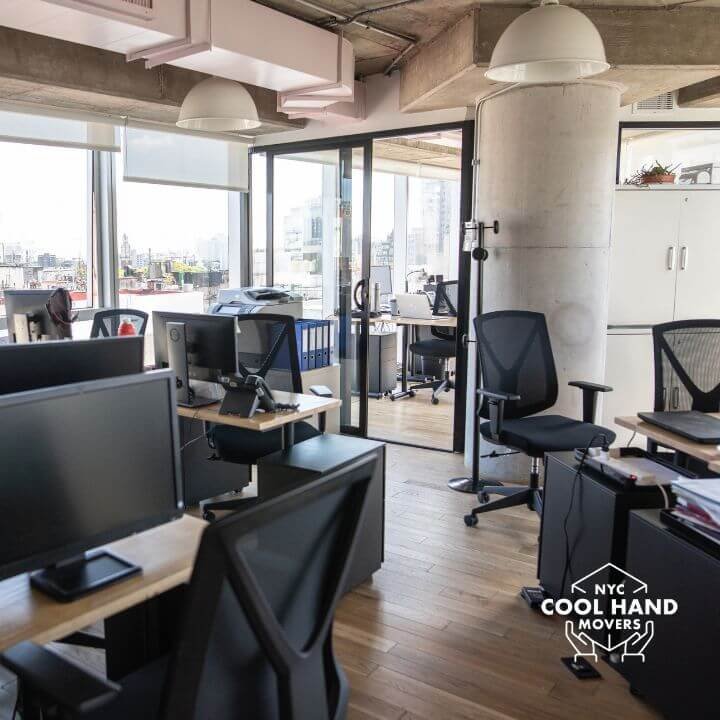Office Move Checklist: An NYC Guide
Office moves are pivotal moments in a company's growth trajectory. A move can mean expanding to accommodate a growing team or downsizing to a more cost-effective space. Transitions like these signal progress and evolution. Our office move guide aims to help you start planning for a successful moving process. We’ve laid out a helpful timeline to keep you on track for your move.
6-12 Months Out from Your Office Move
Create an Office Moving Budget
What can you afford to spend on your new work environment? Establishing a realistic budget is essential for managing expenses associated with the move. This includes costs for hiring movers, purchasing packing materials, and any unforeseen expenses. By outlining a budget early on, businesses can avoid financial strain and allocate resources effectively.
What to consider when looking for an office space:
These are tips to remember even if you're working with a commercial real estate broker. You know your business's needs better than anyone else.
Location & Access: Know the building's hours of operation and make sure you'll have access whenever you need it. The location should also be reasonably accessible to any employees required to work in the office.
Office Layout: Do you like open plan, without cubicles? Will your team hot desk? The space should lend itself to your preferred desk and office layout.
Security: Employees, equipment, data; can the office space you're moving to provide safety for all three? Front desk check-in or turnstiles that scan employee I.D.s may be essential features. You may also want a keypad for entering your specific office suite.
Internet Connectivity & Cell Reception: At the walkthrough, ask if there is an active wi-fi network that you can test. Make a call on your mobile phone.
Utilities & Facilities: Just like when you are looking for a new home, you should test that the electricity and plumbing are functional.
Customization: Some property managers can facilitate custom buildout, like adding phonebooths or walling in conference space.
Find a New Office Space
In NYC, interest in office space is up to nearly 70% of pre-pandemic levels. Buying and renting an office space are back. That means the market is getting more competitive again. Working with an experienced commercial real estate agent can help you navigate numerous listings. Some co-working spaces are still offering deals on rent as occupancy slowly creeps back up.
6 Months Out
Establish a Timeline
Set a clear timeline from packing to setting up utilities in the new space.
A detailed schedule will help you complete the necessary tasks before they're overdue. Give your team time before the moving date to find a moving company and secure your preferred service date. Share the timeline with your team so everyone is on the same page.
Contact Service Providers
To ensure a smooth transition, contact I.T. and utility providers about services for your new office. Also, talk to the property manager about what services are available and potentially included with your lease.
2-3 Months Out
Get Moving Requirements
Office buildings often have specific restrictions around moving and insurance requirements. Find out what they are in advance so that you and your movers are not surprised when it comes time to load out a space and access elevators.
Hire an NYC Office Moving Company
Hire office movers with a strong reputation for delivering great service, and who can provide the requisite insurance. Office moving may require special preparation so don’t hesitate to ask each company you consider if they can carry out what you need. Quality office relocation services don’t have to break the bank. Ask about moving discounts. Mention the commercial organizations you’re a part of to see if any rebates apply.
Choose Boxes or Bins for Office Packing
Some companies can provide sturdy, reusable moving boxes for packing. They can deliver the moving bins in advance or bring them on move day to get you packed. If you opt not to use bins, gather adequate packing supplies such as boxes, tape, packing paper, and bubble wrap. You'll also need markers for labeling.
Purge & Digitize
Digitizing paper documents and files can reduce clutter and improve access to what you need. Scanning software and services help convert physical records into digital format, saving physical space and enhancing document security.
Assign Team Members Roles
Assigning team responsibilities helps the company account for company property and personal items during the move. For example, let employees know if they'll be responsible for packing their workstations. You can also delegate tasks such as inventory management, communication with vendors, and coordinating with the moving company. Make sure the movers have contact information for the right person on move day.
1-2 Months Out
Create an Inventory
Before packing begins, conducting a thorough inventory of all office assets and belongings is essential. The inventory will help track items during transit and streamline the unpacking process at your new office space.
Create an Office Floorplan
Now that you know everything that will be coming along to the new workspace, plan out where everything will go. You may also be introducing some new furniture. Use actual dimensions of large furniture to ensure that everything will fit with enough space for a functional, safe environment. Plan out seating so packed workstations can be delivered to the right area.
1-2 Weeks Out
More Office Moving Timeline Items
Office relocation checklists may include additional items specific to your business. Here are more to-dos that may apply to your office move:
☐ Hire a cleaning service.
☐ Consider moving insurance.
☐ Find handlers for specialized equipment.
☐ Source new furniture and I.T. equipment.
Pack & Label
Implement a clear labeling system for moving bins and any loose items. Labels should indicate box contents and destination so movers and employees can deliver them to the correct locations.
Change Your Address
Mail forwarding via USPS is short-term and doesn't apply to all kinds of mail. For crucial business communications, like those from your banks and credit cards, you'll likely have to update your address directly with each institution.
Moving Day
It's here! If you've hired movers to pack the space, be a helpful guide during the initial walkthrough. Then, try to give them space to work. Point out any items needing special care and those to be disposed of or donated instead of delivered. Do a final walkthrough of the office to ensure no items are left out of the move. Remember that commercial vehicles can't travel the same roads as personal cars, so the movers may take a little longer to arrive at the new workspace.
After the Move
Unpacking
The relocation process doesn't end when everything comes off of the moving trucks. There is still plenty to do as far as getting situated in the new space. If you didn't have the opportunity to earlier, now is the time to find a place for everything that has come over from the old office. You may find it helpful to purge more items. You'll almost certainly discover a couple of new things that would be handy to have.



